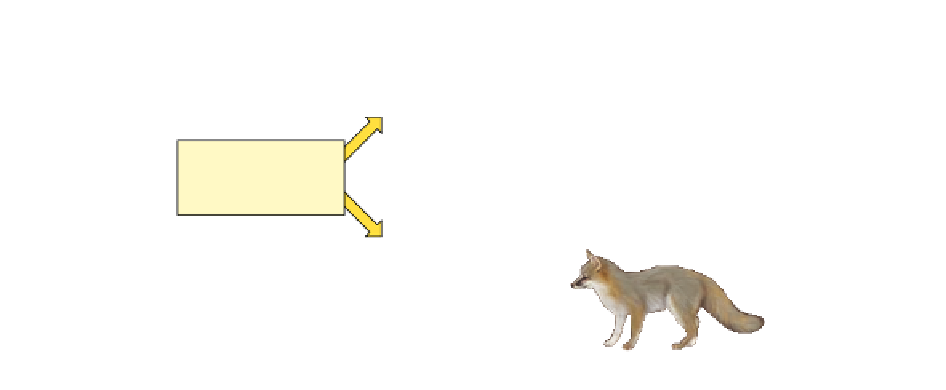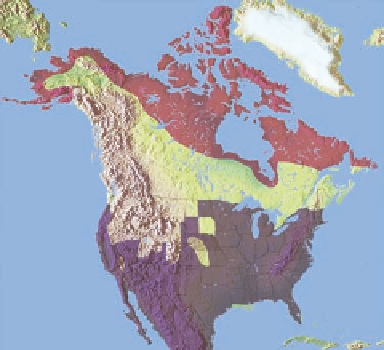Environmental Engineering Reference
In-Depth Information
Adapted to cold
through heavier fur,
short ears, short legs,
short nose. White fur
matches snow for
camouflage.
Arctic Fox
Northern
population
Spreads northward
and southward
and separates
Different environmental
conditions lead to different
selective pressures and evolution
into two different species.
Early fox
population
Gray Fox
Southern
population
Adapted to heat
through lightweight
fur and long ears,
legs, and nose, which
give off more heat.
Figure 4-7
Geographic isolation
can lead to reproductive isolation, divergence, and speciation.
In
reproductive isolation,
mutation and natural
selection operate independently in the gene pools of
geographically isolated populations. If this process
continues long enough, members of the geographically
and reproductively isolated populations of sexually re-
producing species may become so different in genetic
makeup that they can never produce live, fertile off-
spring. Then one species has become two, and specia-
tion has occurred.
For some rapidly reproducing organisms, this type
of speciation may occur within hundreds of years. For
most species, it takes from tens of thousands to mil-
lions of years.
Given this time scale, it is difficult to observe and
document the appearance of a new species. Thus many
controversial hypotheses attempt to explain the details
of speciation.
planet, and releases of large amounts of methane
trapped beneath the ocean floor. Some of these events
created dust clouds that shut down or sharply reduced
photosynthesis long enough to eliminate huge num-
bers of producers and, soon thereafter, the consumers
that fed on them.
In some places, populations of existing species
have been reduced or eliminated by newly arrived
migrant species or species that are accidentally or de-
liberately introduced into new areas. More recently,
humans have taken over or degraded many of the
earth's resources and habitats. Today's biodiversity
represents the species that have survived and thrived
despite environmental upheavals.
Background Extinction, Mass Extinction,
and Mass Depletion
All species eventually become extinct, but drastic
changes in environmental conditions can eliminate
large groups of species.
Extinction is the ultimate fate of all species, just as
death awaits all individual organisms. Biologists esti-
mate that 99.9% of all the species that ever existed are
now extinct. The human species will not escape this ul-
timate fate.
As local environmental conditions change, a cer-
tain number of species disappear at a low rate, called
background extinction.
Based on the fossil record and
analysis of ice cores, biologists estimate that the aver-
age annual background extinction rate is one to five
species for each million species on the earth.
In contrast,
mass extinction
is a significant rise in
extinction rates above the background level. In such a
catastrophic, widespread (often global) event, large
groups of existing species (perhaps 25-70%) are wiped
out. Fossil and geological evidence indicates that the
earth's species have experienced five mass extinctions
Extinction: Lights Out
Aspecies becomes extinct when its populations
cannot adapt to changing environmental
conditions.
Another process affecting the number and types of
species on the earth is
extinction,
in which an entire
species ceases to exist. When environmental condi-
tions change drastically enough, a species must evolve
(become better adapted), move to a more favorable
area if possible, or become extinct.
For most of the earth's geological history, species
have faced incredible challenges to their existence.
Continents have broken apart and moved over mil-
lions of years (Figure 4-8, p. 72). The earth's land area
has repeatedly shrunk when continents have been
flooded, has expanded when the world's oceans have
shrunk, and has sometimes been covered with ice.
The earth's life has also had to cope with volcanic
eruptions, meteorites and asteroids crashing onto the







